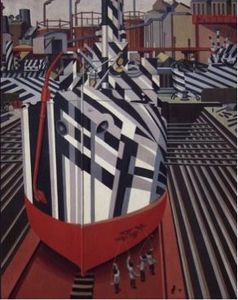The Entitled Interview, with Jamie Sharpe
Jamie Sharpe's Dazzle Ships (ECW Press) uses as its title one of the most interesting historical examples of art and design being used creatively. Dazzle Ships, used mostly during the First World War, were military ships painted with geometric designs intended to visually confuse targeting by enemy weapons - an optical illusion brought to warfare.
It's a fascinating and appropriate title for a brainy, funny, wildly creative collection that investigates the intersection between art and authenticity. Like his previous collection, Animal Husbandry Today, Dazzle Ships showcases a a poet with a talent for crafting fresh, essential poems that balance wit with insightful emotional underpinnings.
We get to talk to Jamie today about his excellent title and the power of titles in general as part of our Entitled Interview series. He tells us about the artist whose work introduced him to the concept of dazzle ships, the (excellent!) title he doesn't remember coming up with, and shares some amazing titles by a favourite writer.
Open Book:
Tell us about the title of your newest book and how you came to it.
Jamie Sharpe:
A few years back I was in Ottawa, hanging out at the National Gallery. There I encountered an Edward Wadsworth painting, Dazzle-ships in Drydock at Liverpool.
Dazzle camouflage is a historical oddity. The idea was to confuse those helming the periscopes on German u-boats by effectively turning US and UK ships into large op art/cubist canvases. Misdirection through the use of beautiful lines struck me as poetic.
I’m also a fan of Orchestral Manoeuvres in the Dark’s 1983 album, Dazzle Ships. That record was influenced by musique concrète—compositions created outside normal instrumentation and music theory—which is analogous to how I sometimes write. (This might just be a way of saying my poems aren’t always poetic and rarely scan.)
OB:
What, in your opinion, is the most important function of a title?
JS:
The reader grants the large font, bold faced title extra weight. As such, there’s pressure on a writer to make the most of their lead here. But the functions a title can fulfill aren’t that different than those of a second line in a poem’s third stanza.
I frequently approach titles as a kind of amuse-bouche, which (hopefully) builds anticipation for the course to come.
Your CanLit News
Subscribe to Open Book’s newsletter to get local book events, literary content, writing tips, and more in your inbox
OB:
Did you consider any other titles for your current book and if so what were they? Why did you decide to go with the title you eventually picked?
JS:
Early in their composition, all three of my poetry collections were originally titled, Works on Paper. That seems the most factual description of my writing, especially given how rarely I do public readings.
The poems I compose are singular, in that they’re not conceived within the framework of a larger manuscript. This becomes a problem when someone, like a publisher looking to make marketing copy, asks, What’s the book about? I then have to sift through the work, trying to group and name what preoccupations prompted the words.
With this book I saw a lot of art as artifice in the material, so went with Dazzle Ships. But I could have just as easily called it Jazz Hands. No, that’s a terrible title.
OB:
What is your favourite title that you've ever come up with and why? (For any kind of piece, short or long.)
JS:
“When Nancy Reagan Recommends the Crab Salad”, from Animal Husbandry Today, if only because I have no recollection writing it. It makes me feel like a forgetful magician entertained by his own trick, as he no longer knows how it was performed.
OB:
What about your favourite title as a reader, from someone else's work?
JS:
Richard Brautigan was good at naming his novels (Trout Fishing in America; In Watermelon Sugar), poetry collections (All Watched Over by Machines of Loving Grace; The Pill Versus the Springhill Mine Disaster), and individual poems (“Your Necklace Is Leaking”; “Hey, Bacon!”).
OB:
What are you working on now?
JS:
I’ve become a little behind in my work; it’s time for me to finally sit down and write my juvenilia.
____________________________________
Jamie Sharpe is the author of Animal Husbandry Today and Cut-up Apologetic. He lives in Comox, B.C.





